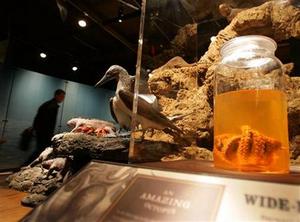It was on July 1, 1858 that papers on the development of animals by Darwin and fellow scientist Alfred Wallace were presented to the Linnean Society in London representing the cream of scientific knowledge. They did not go down well.

|
| ©REUTERS/Shannon Stapleton |
| Specimens are shown at an exhibit marking the work of renowned naturalist Charles Darwin at the American Museum of Natural History in New York November 15, 2005. |
"There was very little reaction in the room," Linnean Society librarian Lynda Brooks said on Wednesday. "But the real furore didn't begin until Darwin published 'On The Origin of Species' the following year."
On July 1 this year the society, which still prides itself as the repository of natural history expertise in Britain, will hold a meeting to discuss how much scientific understanding of the controversial theories has developed since then.
The celebrations will cover three significant events in the life of the shy, retiring scientist who shook the world.
February 2009 will be the 200th anniversary of Darwin's birth and the following November will be the 150th anniversary of the publication of "Origin."
"There is a grandeur in this view of life ... that whilst this planet has gone cycling on according to the fixed law of gravity, from so simple a beginning endless forms most beautiful and most wonderful have been, and are being, evolved," are the concluding lines of the revolutionary book.
Darwin, knowing the reaction he was likely to receive, held back for years from airing and then publishing his theories on the principle of natural selection.
In the end he was stampeded into action by news that Wallace had reached the same conclusions from completely different observations and was about to publish. Both papers were read to the Linneans on the same day.
Darwin's fears were correct. He was pilloried by the scientific and religious establishment of the time.
One famous caricature depicted him with the body of a monkey, so angered were people by the suggestion that they might have descended from the apes rather than having been created in the image of God.
His theories are still rejected by some, notably creationists in the United States, and are less than welcome in the Middle East.
Even in Britain a poll in 2006 showed that only 48 percent of people believed Darwin's evolutionary theories.
The 18 months of events, which include exhibitions and seminars at London's Natural History Museum among others, student exchanges and scientific meetings, will culminate in a three day conference in Egypt in November 2009.



Reader Comments
to our Newsletter